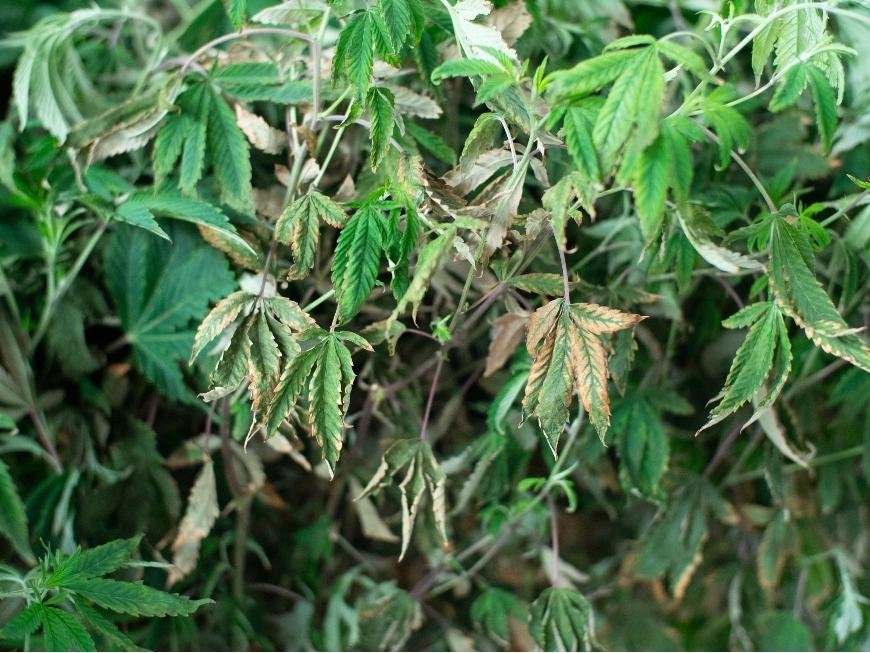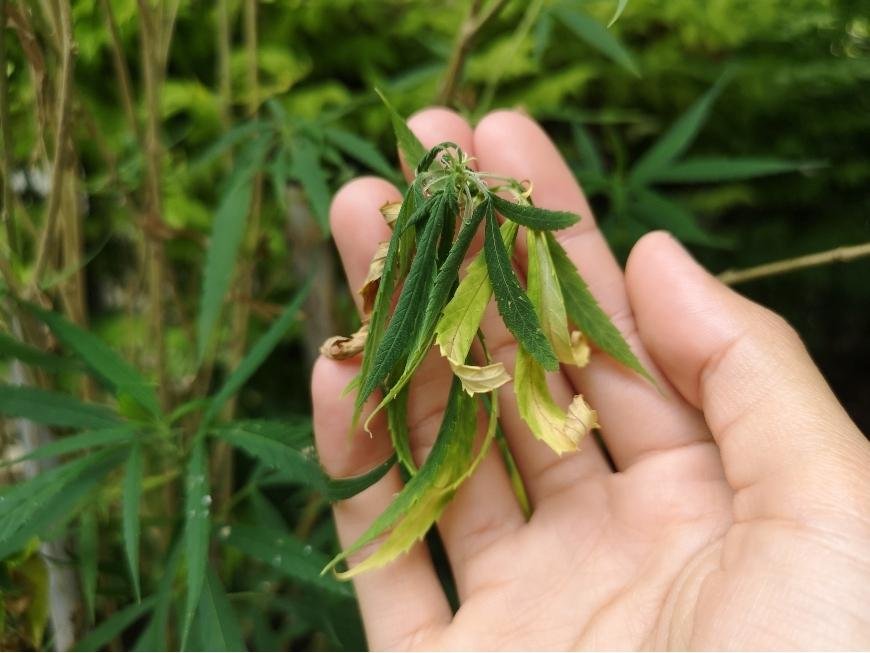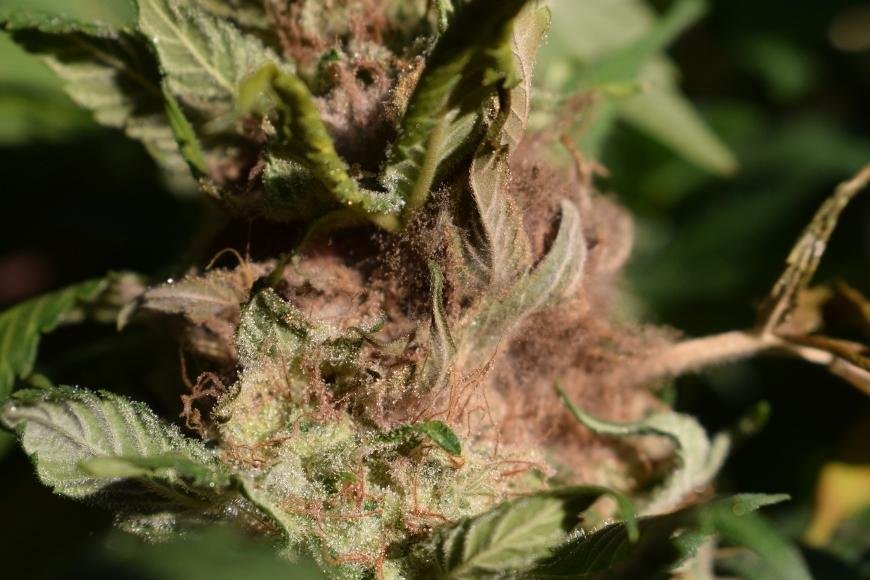How to Identify and Treat Common Cannabis Diseases
Discover how to identify and treat common cannabis diseases, such as powdery mildew and root rot, with our comprehensive guide for healthier plants.

As a passionate marijuana grower, it is essential to be aware of how to spot and treat common cannabis illnesses for the well-being of your vegetation. In this piece, we'll explore the indications, sources and cures of these afflictions that can affect Cannabis sativa.
By learning to recognize early signs of diseases such as powdery mildew and root rot in your cannabis plants, you can take swift action to prevent further damage. We will also discuss preventative measures that can help keep hemp diseases at bay.
Having the know-how to detect and address frequent hemp diseases will give you the capability to keep your plants flourishing during their development.
Table of Contents:
- Recognizing Symptoms of Cannabis Diseases
- Symptoms to Look Out For
- Regular Monitoring and Inspection
- Causes of Cannabis Diseases
- Powdery Mildew
- Root Rot
- Preventative Measures
- Treatments for Cannabis Diseases
- Frequently Asked Questions How to Identify and Treat Common Cannabis Diseases
- Conclusion
Recognizing Symptoms of Cannabis Diseases
Knowing the signs of common cannabis diseases is essential for successful cultivation. As a cultivator, it's critical to consistently observe your plants and be mindful of any alterations in their look or wellbeing. By catching these issues early on, you can take appropriate action before they become more severe and potentially harm your entire crop.
Symptoms to Look Out For
- Discolored leaves: Yellowing, browning, or spotting on leaves may indicate nutrient deficiencies or disease.
- Powdery residue: A white powdery substance on the surface of leaves and stems could be a sign of powdery mildew, a common fungal infection.
- Drooping foliage: Wilting or drooping leaves might signal overwatering, underwatering, root rot, or other problems with the plant's roots.
- Moldy buds: Grayish-white mold growing on buds can indicate bud rot - another type of fungal infection that affects cannabis flowers during their growth phase.
- Insect damage: Holes in leaves and small insects crawling around your plants are signs that pests have invaded your garden. Signs of unwelcome visitors in your cannabis garden could be seen as tiny bugs and holes in leaves, with possible culprits being spider mites, aphids, thrips or caterpillars.
If you notice any unusual symptoms affecting your cannabis plants' overall health or appearance (such as those listed above), it's important to act quickly by researching potential causes online or consulting with experienced growers in your community for advice on how to address the issue.
Regular Monitoring and Inspection
Maintaining a consistent routine of inspecting your cannabis plants is key to catching diseases early on. By checking each plant individually, you can spot any potential issues before they spread throughout your garden. Here are some tips for effective monitoring:
- Daily checks: Look over all parts of each plant every day, paying close attention to leaves, stems, roots (if visible), and buds.
- Note changes: Keep track of any symptoms that appear so you can monitor their progression and take action if necessary.
- In-depth inspections: At least once a week, perform a more thorough examination using tools like magnifying glasses or microscopes to check for pests and other problems not easily visible with the naked eye.
Taking these steps will help ensure that you catch common cannabis diseases early enough to treat them effectively before they cause significant damage or even ruin your entire crop altogether.

Causes of Cannabis Diseases
Comprehending the sources of cannabis maladies can assist in avoiding them from occurring in any case. Various factors contribute to these issues, including environmental conditions, pathogens, and pests. By recognizing and tackling the root causes, you can create a more favorable atmosphere for your plants and decrease the probability of disease outbreaks.
Environmental Factors
Poor growing conditions are often responsible for many common cannabis diseases. Some key environmental factors that can lead to plant health issues include:
- Humidity: High humidity levels promote fungal growth and increase the risk of diseases like powdery mildew.
- Temperature: Extreme temperatures (too hot or too cold) stress plants and make them more susceptible to infections.
- Air circulation: Poor air circulation results in stagnant air around your plants, which encourages mold growth and pest infestations.
- Nutrient imbalances: Over- or under-fertilization can weaken your plants' immune systems, making it easier for pathogens to take hold.
Fungal Pathogens
Fungi are one of the most common culprits behind cannabis plant diseases. They thrive in damp environments with poor airflow - two conditions that often arise when cultivating indoors without proper ventilation systems. Examples of fungal-related illnesses include powdery mildew (Erysiphe cichoracearum), root rot (Fusarium oxysporum), & bud rot (Botritys cinerea).
Pests
Various pests can also cause or contribute to cannabis diseases. These insects feed on your plants, damaging their leaves and stems while potentially spreading pathogens in the process. Common cannabis pests include:
- Spider mites: Tiny arachnids that create webbing on plant leaves and suck out their nutrients.
- Aphids: Small insects that pierce plant tissues to extract sap, often leaving behind a sticky residue called honeydew which attracts mold growth.
- Fungus gnats: Larvae of these small flies feed on roots, causing damage and making it easier for root rot pathogens to invade.
To effectively prevent and treat common cannabis diseases, it's essential first to understand the underlying causes. By addressing environmental factors like humidity, temperature, air circulation & nutrient imbalances - as well as keeping an eye out for fungal pathogens & harmful pests - you'll be better equipped to maintain healthy plants throughout the cultivation process.
Powdery Mildew
Powdery mildew is a fungal disease that affects cannabis plants and can be identified by its white, powdery spots on leaves and stems. This common issue can significantly impact the health of your plants if left untreated, leading to reduced yields or even plant death.
Causes of Powdery Mildew
The primary cause of powdery mildew in cannabis plants is high humidity combined with poor air circulation. When these conditions are present, the fungus thrives and spreads rapidly throughout your grow space. Other factors that contribute to the development of this disease include:
- Overcrowded plants
- Inadequate ventilation systems
- Excessive watering practices
- Lack of direct sunlight exposure for outdoor grows
Symptoms and Identification
To identify powdery mildew on your cannabis plants, look for the following symptoms:
- White powder-like substance: The most obvious sign is a white, dusty coating on leaves and stems.
- Curling or twisting leaves: Affected leaves may begin to curl up or twist as they struggle against the infection.
- Brown patches: If left untreated, brown patches will appear where infected areas die off due to lack of nutrients from photosynthesis.
- Weakened growth: Your plant's overall growth rate may slow down as it battles against this invasive fungus.
Treatment Options for Powdery Mildew Infestations
If you discover powdery mildew on your cannabis plants, it's essential to act quickly and implement an effective treatment plan. Here are some options to consider:
- Milk spray: A simple solution of milk and water (1 part milk to 9 parts water) can be applied as a foliar spray every few days until the infection clears up.
- Baking soda mixture: Combine 2 tablespoons of baking soda with a gallon of water, then add a few drops of liquid soap or horticultural oil for better adhesion. Spray this solution onto affected areas once per week.
- Neem oil: This natural pesticide has antifungal properties that make it an excellent option for treating powdery mildew infections. Mix 2 tablespoons of neem oil with a gallon of water and apply as needed.
- Sulfur-based fungicides: Products containing sulfur can help combat powdery mildew when used according to label instructions. Be sure not to use these products during flowering, as they may affect bud development.
In addition to these treatments, remember always practice good hygiene in your grow space by removing infected leaves promptly and sterilizing any tools used during the process.
Root Rot
Root rot is a fungal disease that can cause stunted growth and yellowing leaves in cannabis plants if left untreated. This destructive condition occurs when the roots of your cannabis plant are exposed to excess moisture, poor drainage, or contaminated soil. The fungi responsible for root rot thrive in these conditions and can quickly spread throughout your plant's root system.
Symptoms of Root Rot
- Lower leaves of the plant will start to yellow, signaling a possible onset of root rot.
- Wilting: Affected plants may appear wilted despite receiving adequate water.
- Brown or black roots: When you inspect the roots, they will be dark brown or black instead of their healthy white color. They may also have a slimy texture.
- Foul smell: A strong, unpleasant odor coming from your plant's growing medium could indicate an advanced case of root rot.
Causes and Prevention
To prevent root rot from affecting your cannabis plants, it's essential to understand its causes:
- Poor drainage: Ensure that your growing medium has proper drainage by using well-aerated soil mixes or adding perlite to improve air circulation around the roots. You should also use pots with sufficient holes at their base for excess water to escape easily.
- Overwatering: Waterlogged conditions create an ideal environment for fungi responsible for causing root rot. To avoid overwatering, make sure you allow the soil to dry out between watering sessions.
- Contaminated growing medium: Always use sterilized soil or coco coir when planting your cannabis seeds or clones. This will help prevent introducing harmful fungi into your grow environment from the start.
Treatment Options for Root Rot
If you suspect that your cannabis plant is suffering from root rot, it's crucial to act quickly and apply appropriate treatments:
- Trim affected roots: Carefully remove any brown, slimy roots with sterile scissors. Be cautious not to damage healthy white roots in the process.
- Improve drainage and reduce moisture: Adjust your watering schedule and ensure that excess water can drain freely from the pot. You may also consider adding perlite or other aerating materials to improve air circulation around the remaining healthy roots.
- Use beneficial microbes: Introduce products containing beneficial bacteria and fungi like Bacillus subtilis or Trichoderma spp., which can help fight off root rot pathogens.
- Fungicides: In severe cases of root rot, applying fungicides specifically designed for treating this disease might be necessary. Avoid using chemical fungicides when possible, as they can be detrimental to plants and the environment; instead, by recognizing root rot symptoms early and implementing proper treatments, you can protect your cannabis crop for a plentiful harvest.
By recognizing the symptoms of root rot early and implementing appropriate treatments, you can save your cannabis plants from this destructive disease and enjoy a healthy, bountiful harvest.
Preventative Measures
Taking preventative measures such as maintaining a clean grow environment, minimizing plant stress, and using neem oil or beneficial insects can help protect against disease outbreaks in cannabis plants. By being proactive with your growing practices, you can ensure that your plants remain healthy and productive throughout the cultivation process.
Maintaining a Clean Grow Environment
A clean grow environment is crucial for preventing diseases from taking hold of your cannabis plants. To maintain cleanliness:
- Regularly sanitize all tools, pots, trays, and surfaces to remove any potential pathogens.
- Avoid bringing outdoor contaminants into the grow space by changing clothes or wearing dedicated indoor shoes.
- Keep humidity levels under control to discourage mold growth - aim for around 40-50% relative humidity during vegetative growth and below 40% during flowering.
Minimizing Plant Stress
Cannabis plants are more susceptible to diseases when they're stressed. Minimize stress by:
- Maintaining consistent temperature (between 70-85°F) and lighting conditions in the grow room.
- Giving proper nutrients according to each stage of plant development - avoid overfeeding or underfeeding them.
- Avoiding overcrowding - give enough space between each plant so air circulates properly without causing excess moisture buildup on leaves which could lead to fungal infections like powdery mildew.
Using Neem Oil & Beneficial Insects
Neem oil is an organic pesticide that can be utilized to both forestall and address a variety of cannabis-related ailments, including powdery mildew and spider mites. To use neem oil:
- Mix it with water according to the product instructions.
- Spray your plants every one or two weeks during vegetative growth as a preventative measure.
- If you spot any signs of disease, increase the frequency of spraying to once every three days until symptoms subside.
In addition to neem oil, introducing beneficial insects like ladybugs or lacewings into your grow space can help control pests naturally without resorting to harsh chemical pesticides. These insects feed on common cannabis pests such as aphids and spider mites, keeping their populations in check while minimizing damage to your plants.

Treatments for Cannabis Diseases
Addressing common cannabis diseases promptly and effectively is crucial to protect your plants and ensure a healthy, bountiful harvest. In this section, we will discuss various treatments for the most common cannabis diseases.
Powdery Mildew Treatment
If you notice powdery mildew on your cannabis plants, it's essential to act quickly. First, remove any heavily affected leaves or branches using clean pruning shears. Then apply an organic fungicide such as neem oil or potassium bicarbonate directly onto the remaining infected areas of the plant. Make sure to follow product instructions carefully and avoid applying these treatments during high temperatures or direct sunlight.
Root Rot Treatment
Root rot can be challenging to treat once it has taken hold of your cannabis plants; however, there are still steps you can take in an attempt to save them. Start by removing any dead roots from the plant with sterilized scissors and then transplant into fresh soil that has good drainage properties. You may also consider adding beneficial microbes like mycorrhizae fungi which help promote healthy root growth while suppressing harmful pathogens.
Bud Rot Treatment
To combat bud rot, begin by carefully removing all visibly affected buds using sterile tools so as not to spread spores further throughout your crop. Next, improve air circulation around your plants by trimming excess foliage and ensuring proper spacing between them. Finally, look into employing a natural antifungal such as neem oil or Bacillus subtilis to help impede additional outbreaks.
Preventative Measures for Future Outbreaks
In addition to treating existing cannabis diseases, it's essential to take steps towards preventing future outbreaks:
- Maintain a clean grow environment by regularly sanitizing tools and surfaces.
- Ensure proper air circulation and humidity control within your grow space.
- Avoid overwatering plants, which can lead to root rot and other fungal issues.
- Inspect new plants for signs of disease before introducing them into your garden.
Treating common cannabis diseases requires vigilance in monitoring plant health, quick action when symptoms arise, and an understanding of the most effective treatments available. By staying informed about potential threats and taking preventative measures against these diseases, you can keep your cannabis plants healthy throughout their growth cycle.
Frequently Asked Questions How to Identify and Treat Common Cannabis Diseases
What are the common diseases of cannabis?
Cannabis plants can be affected by various diseases, with some of the most common being powdery mildew, root rot, and nutrient deficiencies. These issues can cause a range of symptoms such as yellowing leaves, stunted growth, and reduced yields.
What are the most common pathogens in cannabis?
The most common pathogens affecting cannabis plants include fungi like powdery mildew, root rot-causing Pythium, and pests like spider mites or aphids. Proper care and preventative measures can help minimize their impact on your plants.
What are the symptoms of cannabis diseases?
Symptoms vary depending on the disease but may include leaf discoloration (yellowing or browning), curling or wilting leaves, white powdery residue on foliage (indicative of powdery mildew), moldy-smelling roots (suggestive of root rot), slowed growth rates, and overall plant decline.
What disease is killing my cannabis plants?
To determine which disease is affecting your plants, closely examine their symptoms. Powdery mildew presents as a white powder-like substance on leaves; root rot causes blackened or slimy roots with an unpleasant odor; nutrient deficiencies often result in discolored leaves.
Conclusion
After reading this guide on how to identify and treat common cannabis diseases, you should now have a better understanding of the symptoms and causes of these issues. By being able to recognize signs such as white powdery mildew or root rot, you can take preventative measures to protect your plants from becoming infected. If your plants are affected by a fungal infection or other disease, take swift action to save your crop. Acting swiftly is essential for safeguarding your harvest.






















































































































